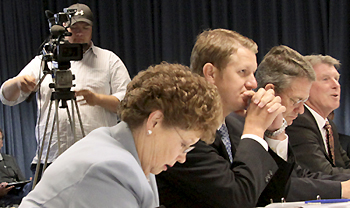
| CONNECTIONS |
IDAHO
ITD
HOME
511 TRAVEL SERVICES
IDAHO
DMV
ITD
NEWS
HIGHWAY
SAFETY
IDAHO STATE POLICE
STATE OF IDAHO
NIATT
NATIONAL
AASHTO
AAMVA
AAA of IDAHO
FEDERAL HIGHWAYS
FEDERAL AVIATION
IDAHO STATE POLICE
NHTSA
NTSB
TRB
U.S. DOT
TRANSPORTER
Archives
Milestones
Comments
Idaho
Transportation
Department
Office of Communications
P.O. Box 7129
Boise, ID 83707
208.334.8005
Fax: 208.334.8563

Task force members share perspectives on the work ahead

Legislators, business leaders and local government officials bring unique perspectives and experiences to the Governor’s Task Force on Modernizing Transportation Funding in Idaho. The group, which is under the leadership of Lt. Gov. Brad Little, met for the first time in Boise Thursday.
After Gov. C.L. “Butch” Otter set the stage for what could be an 18-month process, each of the task force members shared their vision for what they hope to accomplish. Here, in paraphrased form, are some of their comments:
-
We need to recognize the issue we have in maintaining our transportation structure; roads touch everybody’s lives every day.
-
Issues are more than funding; we need to look at the whole management structure of the transportation system; consider needs vs. wants
-
Maintenance of roads is something we cannot overlook; prioritize what we do, including safety and traffic (congestion); hope to identify a stable source of funding
-
90 percent of forest products in Idaho leave the state, primarily by truck. Idaho’s competitiveness in a global economy depends on an efficient transportation system
-
We need to consider studies that have been conducted in the past, including the Governor’s Blue Ribbon Task Force, the Forum on Transportation Investment, the 2008 governor’s statewide funding conferences and the Legislative audit; the task force needs to reach a consensus
-
Base conclusions not just on logic, but practicality
-
We’re in a period of great change, not only in Idaho, but nationally, especially the economic conditions; leaders are very passionate about their transportation system; this process provides a great opportunity to think differently about funding and the infrastructure itself; the funding system needs to be flexible … think outside the existing toolbox
-
The funding process needs to take a long-range emphasis; begin by looking 20-30 years into the future and then work back to the present to determine how we get there; solutions need to be flexible enough to adapt to changing needs, especially those we have not imagined yet
-
The broad approach also should consider rail, air transportation, barges, waterways and public transportation; “we have no monopoly on good ideas;” involve all possible constituencies
-
Don’t neglect our history, but consider how our highways have changed the past century; it has taken a lot of planning and effort to get here; consider local systems as part of the state system
-
Remember the impact transportation has on Idaho’s recreation as a valuable commodity; consider why the highways have been built the way they have
-
The task force should devote the time necessary to reach sound conclusions, even if it takes 18 months as authorized; look at the extent of our needs; what was the projected shortfall in maintenance funding based on? Rethink the way highway conditions are classified; is it appropriate to define them as good, fair, poor and very poor?
-
The bottom line is to maintain our existing infrastructure… how will we raise the funds and who will pay? What form of new revenue will be needed? We need better enforcement of existing laws.
-
It is no accident that, at the federal level, two of the most difficult issues are transportation and energy. We’re seeing a paradigm shift that will reshape how we use the transportation system and the vehicles we will drive. The task force recommendations must be clear and easily understood; individual biases must be sacrificed; keep the process open
-
Those responsible for operating Idaho’s transportation system should be complimented; the transportation department has a lot of expertise and dedicated personnel; citizens have great expectations; we need to determine how to sustain and grow the state’s economy through a sound, well-operated transportation system
-
Look at the role of the federal government; task force members need to be united and fully engage the federal government as it works on reauthorization of the transportation bill
-
We have discussed transportation funding extensively in the Legislature the past few years; no other topic has been discussed more than transportation and transportation funding. The responsibility of the task force is to arrive at a solution to bridge the funding gap. We have a good idea that we have a problem; what we need is a solution for now and the next 20-30 years.
Governor Otter concluded the discussion by saying he was impressed that task force members considered value before costs. When there is fundamental agreement on value, cost and funding will follow, he said.
Published 8-7-09